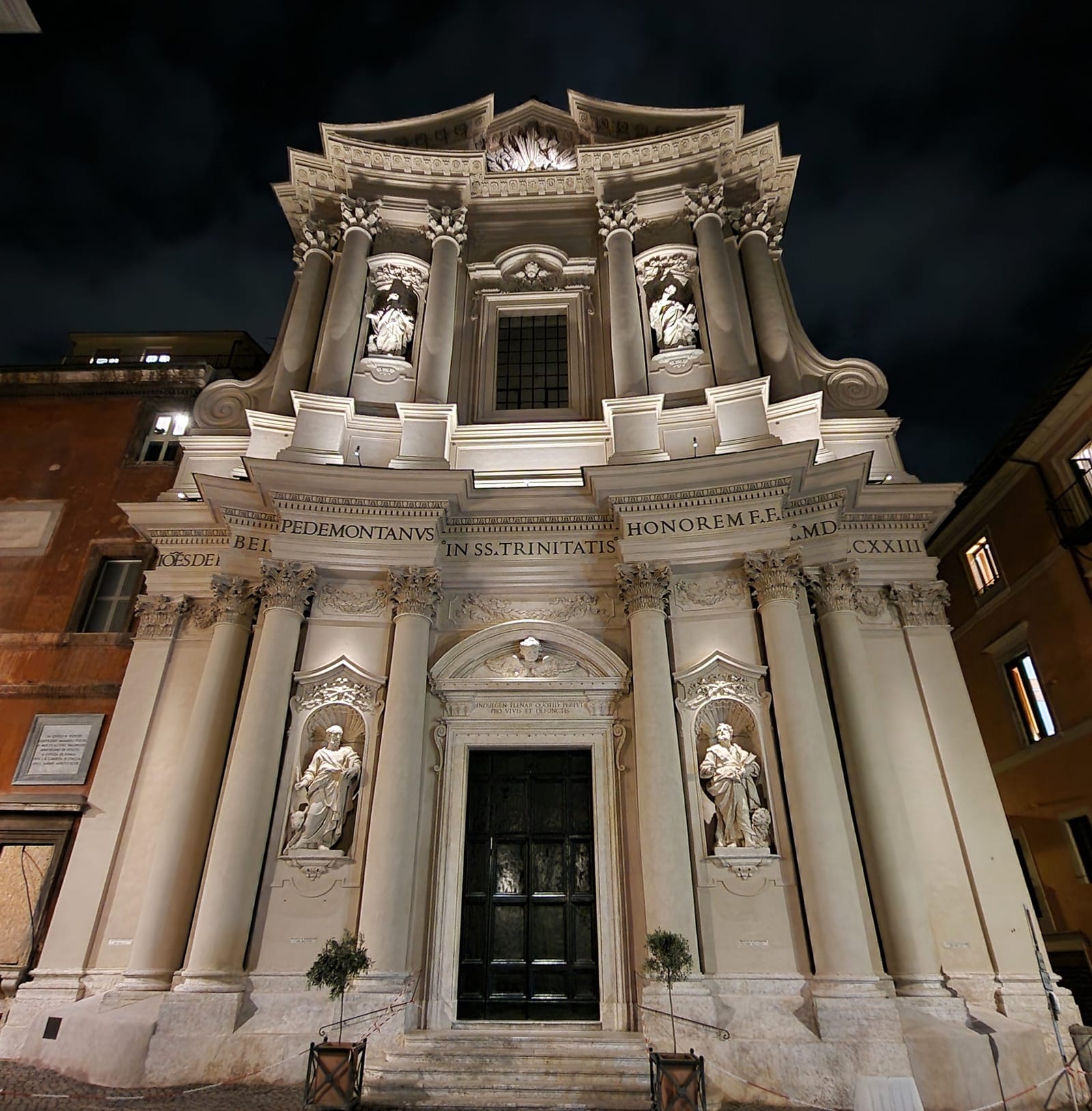
Walking in the heart of Rome, Romans and pilgrims alike pass through one construction site to the next as the Eternal City prepares for the Jubilee Year of 2025.
The Pope will open the Holy Door of Saint Peter’s Basilica and inaugurate the Jubilee Year on Christmas Eve, Dec. 24, 2024.
On the Feast of the Ascension, May 9, 2024, the Bull of Indiction of the Jubilee 2025 was read at Vespers celebrated by the Holy Father.
First Project Completed for the Jubilee Year of 2025
With the expected 35 million visitors to Rome for the Jubilee Year, the first project to be completed in conjunction with the Jubilee Year is significant. The renovation of the facade of Santissima Trinità dei Pellegrini (Most Holy Trinity of the Pilgrims) has given new life to a parish church in Rome.
A Church Built for Pilgrims
In the old historic center of Rome, the Church of the Most Holy Trinity of the Pilgrims is just steps away from Piazza Farnese and nestled next to Ponte Sisto and Via Giulia. The church dates from the early 17th century, consecrated in 1616.
It was built by the Archconfraternity of the Holy Trinity of Pilgrims, founded and directed by Saint Philip Neri, with the specific mission of welcoming and assisting pilgrims in Rome.
The church therefore traces its roots to the mission of Saint Philip Neri, known as the third Apostle of Rome, who dedicated his work to bringing the faithful back to a lively and zealous practice of the faith through liturgy, processions, and devotions. It is presently under the care of the Priestly Fraternity of Saint Peter (FSSP).
The New Facade
On April 18, 2024, the newly restored facade was illuminated for the first time.
Earlier that day, the project was presented in the Press Room in the Chamber of Deputies of Rome. The Special Superintendent of Rome Daniela Porro was present, as well as the parish priest Father Brice Meissonnier, FSSP, highlighting the collaboration necessary between Church and State in promoting projects of restoration in an ancient city like Rome.
“The important restoration,” Porro said, “is part of a project that straddles culture and spirituality, which brings together the history of this church and of the city of Rome itself with the initiatives for the coming Jubilee.”
The project highlights, “the recovery of beauty,” she continued. “The recently completed restoration of the facade and its illumination are the first pieces of a larger work,” the Roman official noted, “to restore [the church] to its original state, to its original splendor.
More than a Facade
Beyond the resplendent facade lies a deeper pilgrimage, woven into the fabric of tradition and hospitality. As the Jubilee of 2025 beckons, the parish priest, Father Brice told us, “The Archconfraternity of the Most Holy Trinity of Pilgrims and Convalescents, founded in Rome by Saint Philip Neri in 1548, will resume one of its most ancient traditions,” extending a heartfelt welcome to pilgrims with a special pilgrim itinerary for the Jubilee.
Father continued to explain, “In fact, the purpose of this Archconfraternity was to welcome and accommodate free of charge the pilgrims who came in large numbers to the Eternal City for the Holy Year.”
The Archconfraternity and parish no longer possess these buildings to accommodate pilgrims. But, Father Brice noted, “The Archconfraternity will still offer the rite of welcoming pilgrims.”
Pilgrim Credentials
During the Jubilee Year, pilgrims to Rome can receive a special pilgrim’s document from the Archconfraternity. Once a week in the parish church, the confreres will welcome pilgrims for the ceremony of washing their feet.
Father Brice explained, “This ritual desired by Saint Philip Neri, repeats the gesture of Jesus washing the feet of his disciples.”
This will be the ceremonial sign of the beginning of a pilgrim’s Jubilee Pilgrimage.
The pilgrim will then be given a “credential” by the confreres of the Archconfraternity to be signed with a stamp in each of the four major basilicas of Rome: Saint Peter’s Basilica, Saint Paul’s Outside the Walls, Saint John Lateran, and Saint Mary Major.
Ideally, the pilgrim will also visit the additional three minor basilicas which, with the major basilicas, make up the “Seven Church Pilgrimage” of Saint Philip Neri. These three minor basilicas are the Holy Cross in Jerusalem, Saint Sebastian, and Saint Lawrence Outside the Walls.
At the end of a jubilee pilgrimage, with a stamped “credential,” the pilgrim will return to Santissima Trinità dei Pellegrini to collect a “diploma.” The diploma will testify to the visit to the four major basilicas, necessary to receive the plenary indulgence of the Jubilee Year, or to the seven basilicas of the “seven church pilgrimage.”
Father Brice highlighted, “This diploma will be the visible sign and memory of completing the jubilee pilgrimage.”
This article was originally published on ChurchPOP.

Jacob Stein, from Omaha, Nebraska, has a bachelor’s degree in Sacred Theology from the Pontifical University of St. Thomas Aquinas — Angelicum, in Rome. He is presently completing his licentiate in Dogmatic Theology at the Angelicum. He is well-versed in the craft of social media content creation, known for his online apostolate of Crux Stationalis: an exploration of Rome through the eyes of the Catholic Faith







